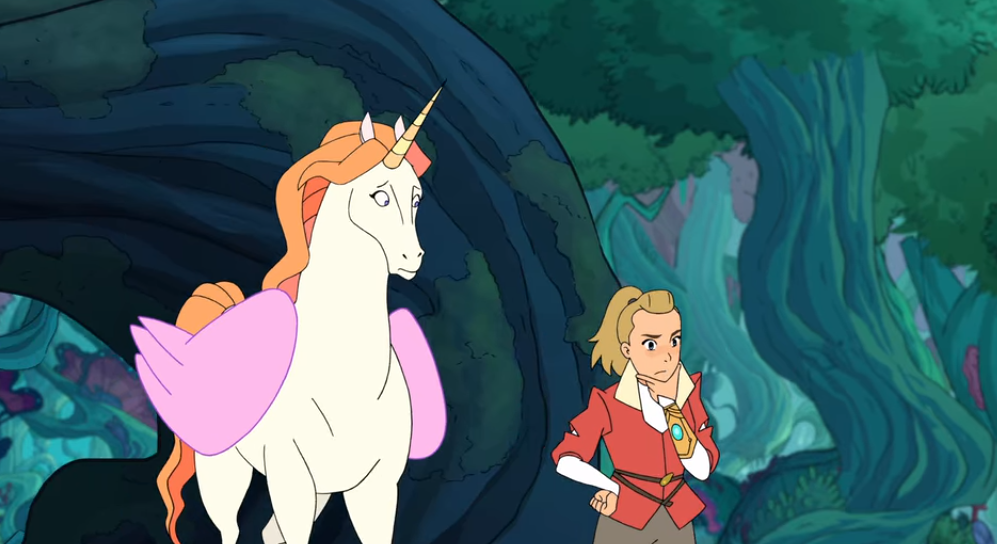Webtoon Review: She-Ra and the Princesses of Power
Princess Glimmer of Bright Moon has a plan. If she and her best friend Bow can find the piece of First Ones technology that he’s detecting in the nearby Whispering Woods, her mother Queen Angella will be so impressed that she will allow Glimmer to take a larger and more active part in the Rebellion against the evil Horde. One big problem, though, the Horde is also after the technology in the person of the improbably named Force Captain Adora.

Adora claims that she saw the sword (for that’s the technology in question) first, but is taken prisoner by Glimmer and Bow. Soon the trio experience life-threatening situations together, followed by a visit to a peaceful village. Adora is confused; she’d been raised to believe that Princesses were dangerous tyrants with uncontrollable powers, and that the Rebellion was just as militaristic as the Horde. When the Horde attacks, Adora finds herself using the Sword of Protection to become She-Ra and fight them off!
Adora begins a process of learning about her new status as She-Ra, a heroic mantle passed down through the ages, and her powers. In an early mishap, she turns an ordinary horse into the talking winged unicorn Swift Wind. She and Bow and Glimmer, as the “best friend squad” start recruiting other princesses into the Rebellion as the second Princess Alliance. (The first Princess Alliance didn’t go so well.)
Back at the Fright Zone, headquarters of the Horde, Adora’s previous best friend Catra is infuriated by Adora’s defection. Their foster parent Shadow Weaver, Lord Hordak’s second-in-command, seems more interested in getting Adora back than in rewarding the more loyal Catra for staying. (Unlike Adora, Catra understood from an early age that the Horde are not the good guys.)
Catra is soon promoted to Force Captain, and rises in the ranks of the Horde, getting a new sidekick in the form of the strong but surprisingly nice Scorpia. Despite Shadow Weaver’s doubts, Catra is soon succeeding in advancing the Horde’s plans more than they had in over a decade. This does, however, repeatedly put her at odds with She-Ra.
This “Netflix Original” series is a reboot of the 1980s She-Ra: Princess of Power animated series, which was a spinoff of He-Man and the Masters of the Universe. Since the parent property’s rights were tied up elsewhere, none of the He-Man characters could be used or mentioned, which necessitated some changes.
Other changes were due to the changed landscape of animated kids’ shows. Instead of being mostly episodic and sticking to a status quo so that viewers who missed an episode or three wouldn’t be confused, the new series has a mostly linear plot with major changes to the status quo each season, and a definite ending. Character designs have more body shape and apparent ethnicity variety. (Some fans were disappointed by the lack of female characters with Barbie doll-type figures, though.)
Good: There’s some fairly deep characterization here. Adora’s training as a Horde soldier keeps affecting her long after she defects (among other things, she keeps her Force Captain outfit except for removing the Horde symbols), and the fact that she used to work for the Horde affects how people react to her. Bow and Glimmer also get character development, though more slowly.
The cycle of abuse affects many of the villainous characters, as we learn their backgrounds as castoffs or unappreciated, which leads them to inflict similar pain on others. Shadow Weaver seems to come to regret her bad parenting to Adora and Catra, but can’t let go of her constant manipulative behavior and words.
The stakes raise constantly as Adora and the others slowly learn the real past of She-Ra and the First Ones, as well as Hordak’s true motivations and background.
Less good: Despite the less episodic nature of the series, some characters have to learn the same important life lessons several times, which get repetitive.
The backstory timeline of the series doesn’t make sense if you think about it too hard. Some of this, admittedly, is because certain characters are lying or concealing information, but even allowing for this there are some gaping holes.
Content note: As mentioned above, abuse, especially emotional abuse, and its effects are a central theme. Torture shows up a couple of times. Deaths happen much less frequently than is realistic, but several deaths or apparent deaths do occur. While the show is generally okay for middle-graders on up, sensitive viewers may want a parent or guardian at hand.
Overall, a good example of how children’s cartoons have changed since the 1980s, often for the better.

